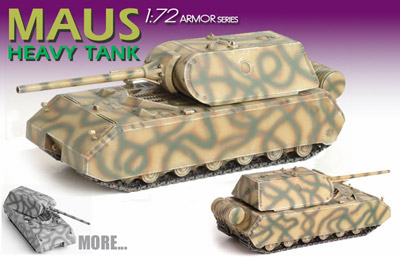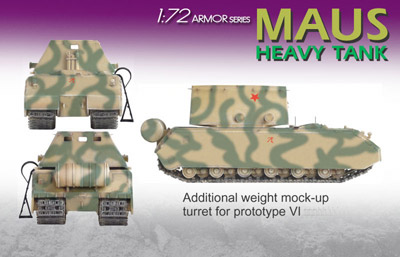Dragon 1/72-scale Pz.Kpw. Maus
(7255)
by Frank De Sisto

in 1/72nd-scale injection-molded styrene plastic. Contains 114 styrene
parts, four DS100 parts and four photo-etchd parts, one accurate decal
scheme (plus generic markings) and four pages of instructions in four
steps. Price: $11.95 USD.

Unlike most of the so-called “Paper Panzers”, Germany actually
completed two of these ungainly beasts, parts of which later found their
way into the Soviet/Russian museum at Kubinka. So, although a rather historically
insignificant vehicle, the Maus continues to be of interest to modelers,
especially those interested in prototypes or “anything German”.
DML originally released this vehicle in 1/35 scale over ten years ago;
now they have followed-up with a Braille Scale version for those who model
in the smaller scales.
There are several areas where DML have improved this kit compared to
the larger kit, and other areas where they have not. The improvements
include properly drilled-out tow points front and rear (including providing
them for the rear; they are not even given on the 1/35th-scale kit); new,
more accurate armor interlock details on the lower bow plate as well as
corrected edges on the lower front/sides of the hull (they are properly
square instead of beveled); added pair of radio antenna mounts on the
forward engine deck, deletion of one of the molded-on periscopes (it’s
separate, but on the prototype was removed, and the opening plated over,
sometime during the development stage) on the turret and improved method
for mounting the 12.8cm main gun (the part that enters the mantlet is
properly wider). In-accurate items still present include overly large
and improperly configured pistol port depressions on the turret sides,
and improperly configured lower turret front (the rounded portion should
merge smoothly with the bottom without the step as given in the kit).
Photos of the V2 hull indicate that the road wheels had small holes (10
or 12) around the rims, but the kit wheels are smooth (which is OK for
the V1 hull). Drilling them out in an evenly-spaced fashion will be a
real chore! All of the others are very easy fixes involving nothing more
than the application of styrene scrap and/or putty. One other thing to
remember is that part E-13 (the large splash plate located centrally on
the forward engine deck) needs to be cut into three pieces to correspond
with the engine access panel seams. Likewise, the instructions don’t
tell the modeler to add rods to the antenna bases. Drill ‘em out
and add ‘em.
The kit has the option of building either of the two completed prototypes.
This includes the turret/weight as mounted on the V1 hull, or the fully-armed
turret seen on the V2 hull. There is a photo-etched step-ladder as seen
on the V1 hull as well as the external fuel drum seen on the V2 hull.
This last item needs a hose leading from it to the engine deck grill as
seen in photos. This is easy to add using appropriately configured plastic
or brass rod. There are also three etched screens to be placed under the
rear deck grills.
The parts in general are crisply molded and nicely detailed. Many of
the plate joints are beveled, but with care during assembly, the parts
in my kit required no more than a quick swipe with fine sandpaper to eliminate
any suggestion of a seam. The entire lower section can be completed before
mating to the upper hull shell, which may aid those who paint their tracks
after they mount them on the kit. Speaking of the tracks, they are nicely
detailed and provided in the DS-100 soft styrene, which can be joined
with conventional plastic cements. The two figures (one standing and one
sitting) are nicely done in DS-100 soft styrene. They will reward careful
painting and give this behemoth some human perspective.
The instructions are well-done but I found one glitch. Do not mount
part B-3 (inner gun tube mount) as shown with the raised notch facing
as shown in the instructions. Reverse it. The painting information is
well-done as far as it goes. The scheme for the V1 hull is fairly correct,
but the two schemes for the V2 are “notional”. The decals
themselves are well-printed by Cartograf and supply the small scale modeler
with plenty of leftovers. These include various styles of tactical numbers
and Balkankreuz national markings.
Altogether, this is a nice, low-priced offering of this unusual, yet
“real” tank. In essence, it is more accurate than its big-scale
brother. It has no major vices and with a bit of work will render a fine
replica of this awesome prototype.
Recommended.
DML kits are available from retail and mail order shops. For details
see their web site at: www.dragonmodelsltd.com.
|